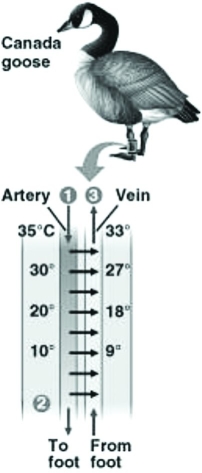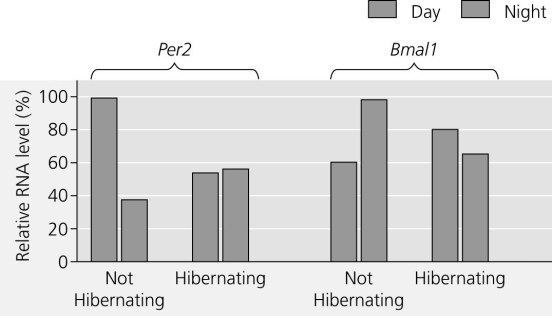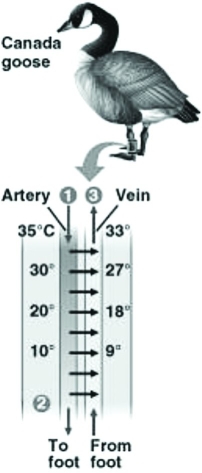A) conduction
B) convection
C) radiation
D) evaporation
Correct Answer

verified
Correct Answer
verified
Multiple Choice
Which of the following organisms is most likely to have the highest total annual energy expenditure per unit mass?
A) elephant
B) horse
C) human
D) mouse
Correct Answer

verified
Correct Answer
verified
Multiple Choice
Use the model of circulation in the leg of a Canada goose to answer the following question.  The countercurrent arrangement of blood vessels is an adaptation that allows the goose to ________.
The countercurrent arrangement of blood vessels is an adaptation that allows the goose to ________.
A) minimize heat exchange between the feet and water
B) generate heat using shivering thermogenesis
C) more effectively cool off the goose in the summer
D) conserve heat in the goose's core when the goose is swimming in cold water
Correct Answer

verified
Correct Answer
verified
Multiple Choice
Which of the following structural features of the digestive system improves the efficiency of exchange of energy and materials with the environment?
A) more branching or folds
B) increased thickness
C) larger cells
D) decreased blood supply
Correct Answer

verified
A
Correct Answer
verified
Multiple Choice
Which of the following would increase the rate of heat exchange between an animal and its environment?
A) feathers or fur
B) vasoconstriction
C) wind blowing across the body surface
D) countercurrent heat exchanger
Correct Answer

verified
Correct Answer
verified
Multiple Choice
Which of the following is a typical characteristic of connective tissues?
A) little space between the membranes of adjacent cells
B) the ability to transmit electrochemical impulses
C) the ability to shorten upon stimulation
D) relatively few cells and a large amount of extracellular matrix
Correct Answer

verified
Correct Answer
verified
Multiple Choice
Which of the following animals most likely uses the largest percentage of its energy budget for homeostatic regulation?
A) a marine jelly (an invertebrate) living deep in the ocean
B) a snake in a tropical forest
C) a shark swimming in the open ocean
D) a bird living year-round in a desert
Correct Answer

verified
Correct Answer
verified
Multiple Choice
You are studying a large tropical reptile that has a high and relatively stable body temperature. How do you determine whether this animal is an endotherm or an ectotherm?
A) You know from its high and stable body temperature that it must be an endotherm.
B) You subject this reptile to various temperatures in the lab and find that its body temperature and metabolic rate change with the ambient temperature. You conclude that it is an ectotherm.
C) You note that its environment has a high and stable temperature. Because its body temperature matches the environmental temperature, you conclude that it is an ectotherm.
D) You measure the metabolic rate of the reptile, and because it is higher than that of a related species that lives in temperate forests, you conclude that this reptile is an endotherm and its relative is an ectotherm.
Correct Answer

verified
Correct Answer
verified
Multiple Choice
Blood is best classified as connective tissue because ________.
A) its cells are separated from each other by an extracellular matrix
B) it contains more than one type of cell
C) its cells can move from place to place
D) it is found within all the organs of the body
Correct Answer

verified
Correct Answer
verified
Multiple Choice
Which of the following is a unique characteristic of smooth muscle?
A) many cells fused together
B) intercalated discs
C) spindle-shaped cells with a single nucleus
D) striations with sarcomeres
Correct Answer

verified
C
Correct Answer
verified
Multiple Choice
To study circadian rhythms in European hamsters, researchers measured mRNA levels for two clock genes (Per2 and Bmal1) in individuals who were not hibernating, and therefore had normal body temperature and individuals who were hibernating, and therefore had lower-than-normal body temperature. Both sets of individuals were kept in total darkness. The results are shown in the figure. Which statement is best supported using the data? 
A) At night, during euthermia, there is more Per2 RNA in the hamster than Bmal1 RNA.
B) During hibernation, the clock genes are regulated differently than during euthermia.
C) The Bmal1 gene is only expressed at night during hibernation.
D) The metabolic rate of the hamsters increased during hibernation.
Correct Answer

verified
Correct Answer
verified
Multiple Choice
What tissue lines most exchange surfaces of multicellular animals?
A) connective tissue
B) smooth muscle
C) neural tissue
D) epithelial tissue
Correct Answer

verified
Correct Answer
verified
Multiple Choice
Which of the following is a characteristic of nervous system signals?
A) They allow gradual changes to take place in the body.
B) They travel quickly throughout the body.
C) They usually impact the entire body.
D) They require a voltage change to be transmitted.
Correct Answer

verified
Correct Answer
verified
Multiple Choice
Use the model of circulation in the leg of a Canada goose to answer the following question.  Which of the following is the best interpretation of the model?
Which of the following is the best interpretation of the model?
A) that warmer arterial blood can bypass the legs as needed, when the legs are too cold to function well
B) that warmer venous blood transfers heat to the cooler arterial blood
C) that warmer arterial blood transfers heat to the cooler venous blood
D) that arterial blood is always cooler in the abdomen, compared to the temperature of the venous blood in the feet of the goose
Correct Answer

verified
Correct Answer
verified
Multiple Choice
The panting responses observed in overheated birds and mammals dissipate heat loss by what process?
A) countercurrent exchange
B) acclimation
C) vasoconstriction
D) evaporation
Correct Answer

verified
Correct Answer
verified
Multiple Choice
Compared with a smaller cell, a larger cell of the same shape has ________.
A) less surface area
B) less surface area per unit of volume
C) the same surface-area-to-volume ratio
D) a smaller cytoplasm-to-nucleus ratio
Correct Answer

verified
Correct Answer
verified
Multiple Choice
Which daily quantity is the least reliable indicator of an animal's metabolic rate, independent of whether an organism is an endotherm or ectoderm?
A) food eaten
B) heat generated
C) oxygen used in mitochondria
D) water consumed
Correct Answer

verified
D
Correct Answer
verified
Multiple Choice
Which of the following properties are displayed by cardiac muscle cells?
A) striated appearance and presence of intercalated disks
B) smooth appearance and under voluntary control
C) striated appearance and under voluntary control
D) smooth appearance and presence of intercalated disks
Correct Answer

verified
Correct Answer
verified
Multiple Choice
Measuring which of the following amounts would most accurately determine the metabolic rate of an animal?
A) the work done by an animal
B) the food consumed during a meal
C) the carbon dioxide produced by an animal in a given time.
D) the energy used by an animal in a given time
Correct Answer

verified
Correct Answer
verified
Multiple Choice
Which of the following increases the rate of heat exchange between an animal and its environment?
A) feathers or fur
B) vasoconstriction
C) wind blowing across the body surface
D) a blubber or fat layer
Correct Answer

verified
Correct Answer
verified
Showing 1 - 20 of 58
Related Exams